In this article:
When someone in your home falls ill, it’s important to take proactive steps to stop the spread of germs and maintain a clean and healthy environment for everyone.

Before diving into the details of illness prevention and control, it’s crucial to understand why disinfection is essential after an illness.
Pathogens can survive on surfaces for varying periods, depending on the type of microorganism. (1) Disinfection helps to kill or inactivate these pathogens, minimizing the risk of spreading the infection to others within your household. (2)
But before you get to disinfecting, cleaning the house is important. As experts claim, it’s vital to regularly clean your house by removing dirt and germs from surfaces. Sanitizing comes next, which reduces the remaining germs on surfaces after cleaning.
The last step is disinfecting, which is the most effective step as it can kill viruses and bacteria that might still be present on surfaces.
Note: Experts advise regular cleaning of household surfaces as it is crucial in preventing the spread of specific diseases such as giardia, norovirus, and shigella.
This article will provide a step-by-step guide on how to effectively disinfect your house after an illness.
How to Disinfect Safely
Here are the necessary steps required to safely disinfect your home and get rid of dirt, grime, and germs from household surfaces.
Step 1: Gather the necessary supplies
To begin the disinfection process, gather the necessary supplies. These typically include wipes, gloves, masks, and cleaning tools such as microfiber cloths or sponges with the disinfectant of your choice. (3)
The disinfectant can be store-bought or made at home by diluting bleach.
Chemical disinfecting agents

To effectively disinfect a surface, use a disinfecting product that is registered with the Environmental Protection Agency (EPA) and is capable of targeting a wide range of pathogens. (3)
Before disinfecting, clean the surface with soap and water. Always check the label of the disinfecting product to ensure it can be used on the surface you want to disinfect.
Note: Look for the EPA registration number on the disinfectant to verify the product. The EPA registration number for the main product includes two sets of numbers with a hyphen in between (such as EPA Reg. No. 56789-12). (4)
Ensure the following when using chemical disinfectants: (3)
- Wear the recommended protective gear to shield your skin and eyes.
- Ensure good ventilation indoors.
- Store chemicals safely away from children and pets.
- Avoid mixing different products or chemicals.
- Do not ingest, inhale, inject, or apply disinfectant directly to the skin.
- Avoid using disinfecting products on pets.
- After disinfecting, wash your hands thoroughly with soap and water.
Bleaching agents
If you don’t have chemical disinfecting agents for cleaning, you can use household bleaching products. Bleach is a powerful disinfectant with an active ingredient called sodium hypochlorite, which can effectively kill bacteria, fungi, and viruses, including the flu virus. (5)
When diluted, household bleach can disinfect surfaces within 10-60 minutes of contact. It is widely available and affordable.
To prepare bleach for use, mix 3 tsp of 2% sodium hypochlorite active (bleach) with 1 cup of cool water. (6)
Note: Remember, bleach can irritate the mucous membranes, skin, and respiratory system. So, it should be used cautiously, following safety guidelines and ensuring proper ventilation. (5)
Step 2: Start with the most commonly touched surfaces

Evidence shows that high-touch surfaces function as added breeding grounds for pathogens.
Surfaces such as doorknobs, light switches, countertops, and faucets may accumulate microbes over time. Start your disinfection process by focusing on these areas. (7)
Research has shown that disinfecting door handles works as an effective way of minimizing microbial spreads. (8)
Ensure you cover all surfaces thoroughly and allow the disinfectant to sit for the recommended contact time to maximize its effectiveness. You can keep disposable wipes to clean such surfaces every now and then. (7)
Step 3: Move on to cleaning electronic devices
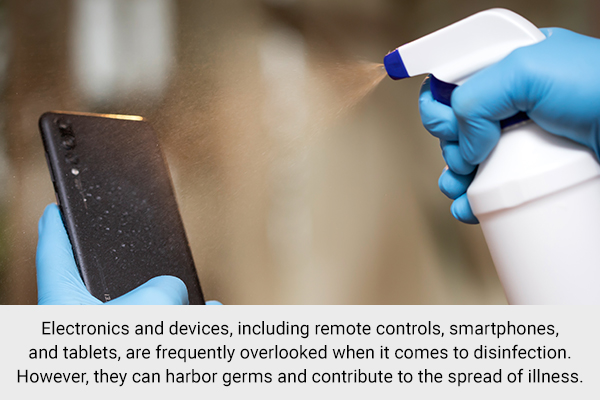
Electronics and devices, including remote controls, smartphones, and tablets, are frequently overlooked when it comes to disinfection. However, they can harbor germs and contribute to the spread of illness.
Experts who study disease outbreaks have pointed out how phones harbor viruses that can cause diseases. (9) This may be because viruses can easily move from smooth surfaces such as your phone’s glass screen to your fingers. (10)
Use alcohol-based wipes and sprays or ammonia products that may or may not be specifically designed for electronics to clean and disinfect these items. (10)(3)
Note: Take care not to saturate your devices with liquid to avoid damage.
Step 4: Pay attention to both soft and hard surfaces
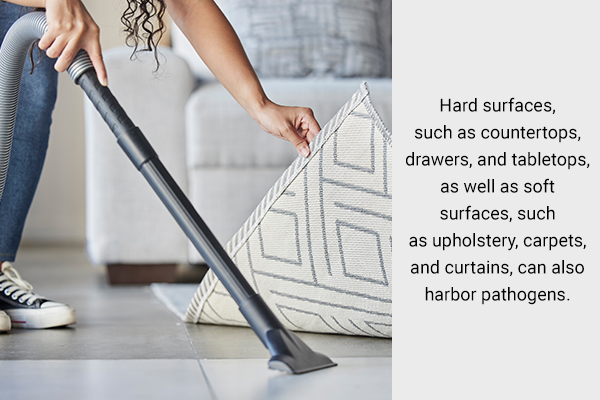
Hard surfaces, such as countertops, drawers, and tabletops, as well as soft surfaces, such as upholstery, carpets, and curtains, can also harbor pathogens. (11)
When it comes to cleaning hard surfaces, a lot of cleaning products and sprays are available. Chemical disinfectants or bleach work the best.
For soft surfaces, you can vacuum them thoroughly to remove any visible dirt or debris, and consider using a fabric-safe disinfectant spray or a steam cleaner. (3)
Step 5: Clean linens and clothing items
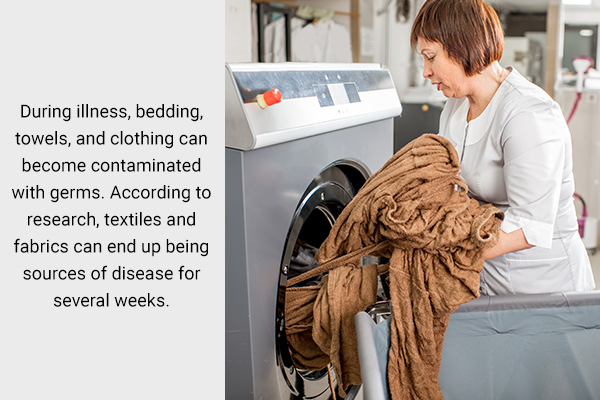
During illness, bedding, towels, and clothing can become contaminated with germs. According to research, textiles and fabrics can end up being sources of disease for several weeks.
Researchers found that bacteria can survive for 200+ days on polyester and 90+ days on cotton at room temperature. (12) So, it’s essential to launder these items properly to eliminate any lingering pathogens.
Here’s what experts suggest: (3)
- Sort your laundry and wash items that can handle hot water.
- Set your washing machine to the warmest water setting (around 40–60°C or 100–140°F).
- Add laundry detergent and, if available, bleach or a color-safe disinfectant.
- Start the wash cycle and let it complete.
- Ensure items are fully dry before folding or storing.
Step 6: Disinfect each room (such as the kitchen and nursery) and related things (such as utensils and toys)
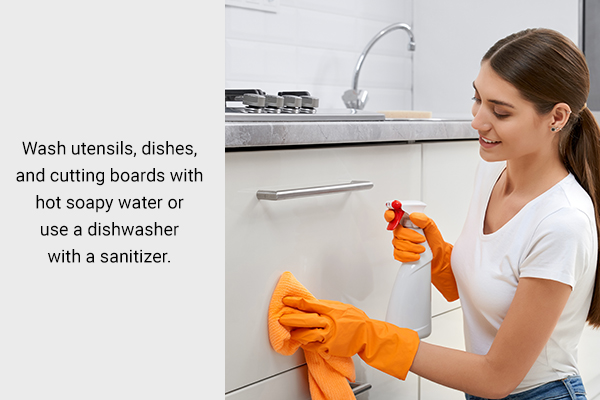
Kitchen
Wash utensils, dishes, and cutting boards with hot soapy water or use a dishwasher with a sanitizer. Also, clean countertops with soap and water, and then disinfect using an EPA-registered disinfectant.
Nursery/kid’s room
Clean and disinfect changing tables or cribs using mild detergent and warm water.
Consider using disinfectant wipes or a solution of water and bleach for toys. To wash baby bottles and pacifiers, disassemble them to clean individually with mild soap and warm water.
You can also sterilize by keeping parts in hot water, if desired.
Living room and bedrooms
Dust surfaces with a microfiber cloth or vacuum with a HEPA filter to remove dust and debris. Clean and disinfect all frequently touched objects and surfaces.
To disinfect makeup brushes and tools, wash them with mild shampoo or a specific cleaner, rinse, and air-dry them completely.
Bathroom and toilet
Clean and disinfect toilet bowls, seats, and sinks using a toilet bowl cleaner and an EPA-registered disinfectant.
Balcony
Sweep or brush the balcony surface to remove dirt and debris. Clean outdoor furniture with soap and water, and disinfect using a disinfectant spray or wipe.
Step 7: Ensure good ventilation by opening windows and doors

Proper ventilation plays a significant role in reducing the concentration of airborne pathogens.
Research has shown that insufficient ventilation increases the risk of disease transmission, whereas higher ventilation rates can decrease the risk of infection. For instance, one study revealed that poorly ventilated rooms have been associated with an increased rate of infection transmission among hospital staff.
In conclusion, good ventilation allows for better dilution of airborne infections, reducing the risk of transmission. So, open your windows and doors to allow fresh air to circulate throughout the house. (13)
Step 8: Practice proper hand hygiene
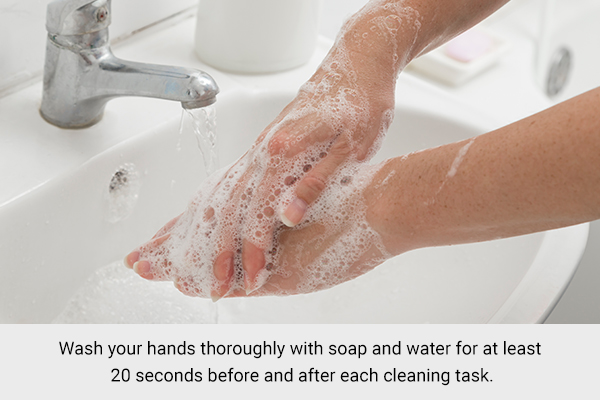
Throughout the disinfection process, it’s crucial to maintain good hand hygiene. Wash your hands thoroughly with soap and water for at least 20 seconds (14) before and after each cleaning task. If soap and water are not available, use an alcohol-based hand sanitizer containing at least 60% alcohol.
Should I Disinfect My House Daily?
It’s worth noting that sanitizing or disinfecting at home to prevent the spread of disease is generally not necessary unless there are sick individuals in your household.
However, in cases where a family member has been affected by a highly contagious infectious disease or has a weakened immune system due to conditions such as HIV/AIDS, tuberculosis, chemotherapy, or organ transplant, larger-scale disinfection measures may be required.
Can I Use Natural Cleaning Products Instead of Disinfectants?
Here are some natural cleaning products that can be used:
- Vinegar: Diluted vinegar can be used to clean and disinfect various surfaces in your home. (15)
- Hydrogen peroxide: It can be employed as a disinfectant and is useful against a good range of bacteria. (16)
- Lemon juice: It can be used to clean countertops, cutting boards, and other items. (17)
- Baking soda: It is a deodorizer and can be used to clean and disinfect surfaces. (18)
Note: While natural cleaning products may be effective for general cleaning, they may not have the same level of efficacy in killing pathogens as approved disinfectants, according to experts. (17)
Most-Asked Questions
What is microbial adherence?
Microbial adherence refers to the ability of microorganisms to stick to surfaces, which helps them establish themselves and cause infections. Some bacteria have structures such as fibrillae, fimbriae, or pili that enable them to bind to human cells in various body parts. (19)
How often should I disinfect my house after someone has been ill?
It is recommended to disinfect your house after someone has been ill, especially if they had a contagious illness.
Do I need to disinfect my house if someone has a mild illness?
Even with mild illnesses, it is still recommended to disinfect your house to minimize the risk of spreading germs. Mild illnesses can still be contagious.
Can animals carry infections?
Yes. According to experts, dogs can carry ticks that transmit diseases such as Lyme disease, Rocky Mountain spotted fever, and ehrlichiosis. Cats are associated with Bartonella henselae infection, reptiles with salmonella infection, rodents with leptospirosis, and rabbits with tularemia.
What precautions should I take when using disinfectants?
When using disinfectants, it is essential to follow the instructions on the product label, including safety precautions such as wearing gloves and ensuring proper ventilation.
Final Word
Maintaining a clean and healthy environment is paramount after an illness. By following proper disinfection practices and paying attention to high-touch surfaces, electronics, soft surfaces, and linens, you can minimize the spread of germs and create a safe space for everyone.
- Was this article helpful?
- YES, THANKS!NOT REALLY


